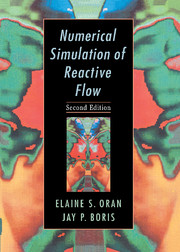Book contents
- Frontmatter
- Contents
- Prologue
- 1 An Overview of Numerical Simulation
- 2 The Reactive-Flow Modeling Problem
- 3 Models and Simulation
- 4 Some General Numerical Considerations
- 5 Ordinary Differential Equations: Reaction Mechanisms and Other Local Phenomena
- 6 Representations, Resolution, and Grids
- 7 Diffusive Transport Processes
- 8 Computational Fluid Dynamics: Continuity Equations
- 9 Computational Fluid Dynamics: Using More Flow Physics
- 10 Boundaries, Interfaces, and Implicit Algorithms
- 11 Coupling Models of Reactive-Flow Processes
- 12 Turbulent Reactive Flows
- 13 Radiation Transport and Reactive Flows
- Index
10 - Boundaries, Interfaces, and Implicit Algorithms
Published online by Cambridge University Press: 09 October 2009
- Frontmatter
- Contents
- Prologue
- 1 An Overview of Numerical Simulation
- 2 The Reactive-Flow Modeling Problem
- 3 Models and Simulation
- 4 Some General Numerical Considerations
- 5 Ordinary Differential Equations: Reaction Mechanisms and Other Local Phenomena
- 6 Representations, Resolution, and Grids
- 7 Diffusive Transport Processes
- 8 Computational Fluid Dynamics: Continuity Equations
- 9 Computational Fluid Dynamics: Using More Flow Physics
- 10 Boundaries, Interfaces, and Implicit Algorithms
- 11 Coupling Models of Reactive-Flow Processes
- 12 Turbulent Reactive Flows
- 13 Radiation Transport and Reactive Flows
- Index
Summary
Boundary conditions are used to represent an infinitely large region of space using a finite computational domain, to describe boundary layers near walls, and to simulate details of chemical reactions, heat transfer, and other surface effects. Developing the correct boundary conditions to use in a numerical model involves complicated physical and numerical issues that make it relatively easy to make conceptual and programming errors. It is necessary to determine the correct boundary conditions to apply, how they should be implemented numerically, and whether there are inconsistencies between these boundary conditions and the description of the physical system within the computational domain. Although it is not always necessary to understand the solution completely to model the interior of a computational domain, implementing physically reasonable and sufficiently consistent boundary conditions requires a strong understanding of the interior and exterior phenomena and how they interact.
Interfaces are internal boundaries that have structure and can move with the flow. When interfaces are present, they greatly increase the complexity of the simulation. Additional physical processes that are not present within the flow field, such as surface tension, evaporation, condensation, or chemical reactions, can be important at these interfaces. Often the behavior of the interface has to be modeled phenomenologically as part of a much larger overall problem. This occurs when there are orders of magnitude difference in the gradients perpendicular to and parallel to the interface. For example, a shock may have a radius of curvature of centimeters or meters, but it may be only a micron thick. The layer in which ice melts and sublimates is only a fraction of a millimeter thick.
- Type
- Chapter
- Information
- Numerical Simulation of Reactive Flow , pp. 353 - 404Publisher: Cambridge University PressPrint publication year: 2000



